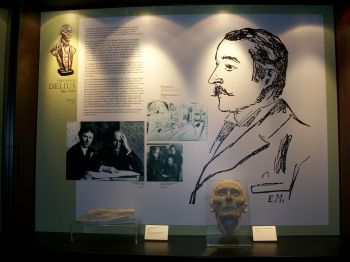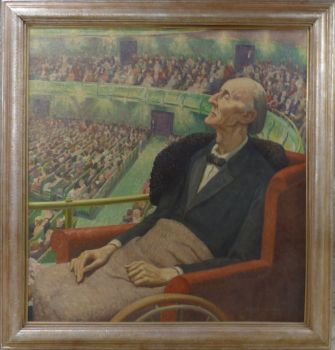Sussex researcher reveals rare art works at Proms exhibition tribute to composer Delius
Posted on behalf of: University of Sussex
Last updated: Monday, 13 August 2012

One of the display panels of the Delius exhibition at the Royal Albert Hall, featuring the death mask, hand cast and picture of a sketch of the composer by Munch

Painting by Ernest Procter of the composer Frederick Delius, on display at Alexandra Loske's exhibition of Delius artifacts at the Royal Albert Hall
The death mask of Frederick Delius and a rarely seen and important portrait of the composer are among the items on display at the Royal Albert Hall, London, in an exhibition curated by Sussex art historian Alexandra Loske.
The exhibition forms part of the celebrations of the 150th anniversary of the composer’s birth that include seven BBC Prom concerts featuring the music of Delius (1862-1934) during the 2012 season at the Royal Albert Hall.
Documents and objects relating to almost all of the Delius works performed at the Proms, as well as rarely seen photographs and paintings of Delius, are included in the exhibition, which can be viewed by all Proms audiences in the ground floor corridor.
A Yorkshire-born musician of German heritage, much travelled and a friend to some of the great names in art and music (the painters Edvard Munch and Paul Gauguin, the Norwegian composer Edvard Grieg), Delius was a passionate, sensual character stimulated and inspired by his surroundings but restricted in later life by illness and blindness. The exhibition aims to capture his appetite for life and experience, rather than the debilitation of later years that is usually the popular focus for Delius.
Some of the objects are extremely rare and fragile and have never been on public display before, provided in the main by the Delius Trust, including the mask made of the composer’s face on his death-bed.
A key exhibit is the rarely-seen portrait by Ernest Procter of Delius (a smaller, better known version of the work is in the National Portrait Gallery).
The picture, showing Delius in a wheeled chair listening to his own “Mass of Life” at the Queen’s Hall (which was destroyed by bombing in World War II) during a Delius Festival (Oct-Nov 1929), was presented in 1938 to the Royal Albert Hall by Sir Archibald Lyle.
Since then it has hung in various locations, including the Hall’s main entrance next to portraits of Sir Henry Wood and Sir Malcolm Sargent. More recently it has been in storage in the Hall’s Archive until this display. In 1978 the picture was identified as a missing portrait by Ernest Procter, of which the National Portrait Gallery had the preliminary study for the head.
Coming face to face with the little-viewed but important work was a rare treat for Alexandra Loske, who is currently completing an Arts and Humanities Research Council-funded doctorate at Sussex, in collaboration with Brighton Museum and Art Gallery, on the interior décor of the Royal Pavilion, Brighton.
Alexandra says: “Here, Delius’s fragile-looking figure is framed by a wheelchair of a deep red colour, his head held high, with an expression of intense concentration despite his debilitating illness. I was struck by how Procter balanced the composer’s silhouetted face with his beautiful long hands resting on his legs. I had already decided to include the cast of Delius’s right hand in the exhibition; and once I saw the hands in this painting I knew we had to try everything to display them together. To me this is all about the sensual experience of music.”
Now, for the first time since 1990, the painting is on view to the public as part of the exhibition.
The death mask was taken by an unknown artist immediately after Delius’s death in 1934 at Grez-sur-Loing in France, along with a cast of his right hand. It is the first time that the mask and the hand cast have been on public view.
Other exhibits of particular interest include sketches of the composer’s hands – Delius had an enviable skill as a pianist in his ability to span two octaves, due to his large hands and long fingers. The sketches, made by the artist Herbert James Gunn, were preparatory work for a full-length portrait of the artist at his home in Grez-sur-Loing in 1932. The portrait is in the collection of Bradford Museums and Galleries.
Alexandra was commissioned to curate the Delius exhibition after Delius Trust Secretary Helen Faulkner saw Alexandra’s exhibition of the one-time Hove-based artist Robert Goff (1837-1922) at Brighton and Hove Museum.
Alexandra says: “The Goff exhibition was a labour of love, and at the end I wondered when I’d get such an opportunity again. And suddenly the Delius Trust needed a freelance curator with an eye for objects and how to display them and good communication and research skills. I was worried that I might not know enough about music, but I was assured that the experts in the field would help and advise.
“Our small team of three had to work extremely fast and efficiently to put the exhibition together before the Proms season. The biggest challenge was the exhibition space. The Royal Albert Hall is a circular building and we had to find wall spaces and display cases that would allow us to show our fragile exhibits safely but cohesively. Normal rules of gallery spaces did not apply here. The challenge was to make this a visually stimulating display, which is why we were keen to include the large Procter painting.
“It was very enjoyable working in a professional capacity on a project that had no other aim than to celebrate the life of a great composer and educate the general public. This was a wonderful final project on the last stretch of my AHRC-funded doctoral studies, and I would probably never have had the opportunity to secure freelance work of this type had it not been for the collaborative nature of my scholarship.”
Additional highlights include artefacts relating to the composer’s Parisian days and the influence of travel and culture on his outlook and friendships, including sketches by Munch and sheet music that belonged to Delius’s champion in England, the conductor Sir Henry Beecham.

